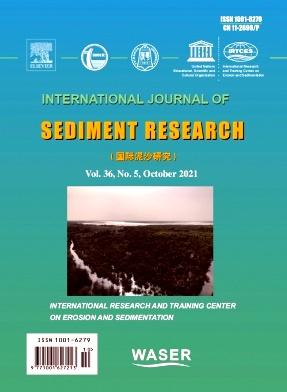利用 RANN-AHA 和 GEP 混合模型模拟冲积河道中的流动阻力和沙丘床面的几何形状
IF 3.7
2区 环境科学与生态学
Q2 ENVIRONMENTAL SCIENCES
引用次数: 0
摘要
多沙河流中沙丘的形成会严重影响水流阻力,进而影响水位、流速、河流航运和水工建筑物的性能。准确预测流动阻力和沙丘几何形状(长度和高度)对于环境工程和河流管理至关重要。本文介绍了两个模型,用于评估沙床河道中形成的沙丘的流动阻力和几何形状。第一个模型 RANN-AHA 是一个混合人工智能模型,使用循环人工神经网络 (RANN) 与人工蜂鸟优化算法 (AHA) 相结合来优化神经网络模型的偏置和权重。第二个模型使用基因表达编程(GEP)作为基于遗传算法(GA)和遗传编程(GP)的非线性方法,明确确定沙丘特征。对于这两个模型,输入参数包括水流和沉积物特征,而曼宁粗糙度系数()和沙丘相对高度/或/则被用作输出参数,其中为沙丘高度,为沙丘顶上的水流深度,为沙丘长度。为进行分析,汇编了五个不同的已公布水槽数据集。使用不同的输入参数组合进行了敏感性分析。结果发现,水力半径除以中值直径 (/)、雷诺数 (Re)、颗粒密度测量弗劳德数 (∗) 和颗粒弗劳德数 ()的组合在估算曼宁和相对高度 / 或 / 时具有最佳预测精度,均方根误差 (RMSE) 分别为 0.00027、0.0504 和 0.0078,相关系数 () 分别为 0.9989、0.942 和 0.9272。模型验证证明,RANN-AHA 模型在预测沙床河道的粗糙度系数和沙丘几何形状时,优于 GEP 模型和大多数先前的文献研究。本文章由计算机程序翻译,如有差异,请以英文原文为准。
Modeling flow resistance and geometry of dunes bed form in alluvial channels using hybrid RANN–AHA and GEP models
Dunes formation in sandy rivers significantly impacts flow resistance, subsequently affecting water levels, flow velocity, river navigation, and hydraulic structures performance. Accurate prediction of flow resistance and dune geometry (length and height) is essential for environmental engineering and river management. The current paper introduces two models to evaluate the flow resistance and geometry of dunes formed in sand-bed channels. The first model, RANN–AHA is a hybrid artificial intelligence model using the recurrent artificial neural network (RANN) linked with the artificial hummingbird optimization algorithm (AHA) to optimize the biases and weights of the neural network model. The second model uses gene expression programming (GEP) as a nonlinear approach based on a genetic algorithm (GA) and genetic programming (GP) to explicitly determine dune characteristics. For both models, the input parameters include flow and sediment characteristics, while Manning's roughness coefficient (nM), and relative dune height, h/H or h/L, were used as output parameters where h is the dune height, H is the flow depth above the dune crest, and L is the dune length. Five different published flume data sets were compiled for the analysis. Sensitivity analysis was done using different combinations of input parameters. It was found that the combination of hydraulic radius divided by median diameter (RH/d50), Reynolds number (Re), Particle densimetric Froude number (F∗), and grain Froude number (FG) yielded the best prediction accuracy for estimating Manning nM and relative height, h/H or h/L, with a root mean square error (RMSE) = 0.00027, 0.0504, and 0.0078 and a correlation coefficient (R) = 0.9989, 0.942, and 0.9272, respectively. Model verification proved that the RANN–AHA model outperformed the GEP model and most of the previous studies available in the literature when predicting the roughness coefficient and dune geometry in sand bed channels.
求助全文
通过发布文献求助,成功后即可免费获取论文全文。
去求助
来源期刊
CiteScore
6.90
自引率
5.60%
发文量
88
审稿时长
74 days
期刊介绍:
International Journal of Sediment Research, the Official Journal of The International Research and Training Center on Erosion and Sedimentation and The World Association for Sedimentation and Erosion Research, publishes scientific and technical papers on all aspects of erosion and sedimentation interpreted in its widest sense.
The subject matter is to include not only the mechanics of sediment transport and fluvial processes, but also what is related to geography, geomorphology, soil erosion, watershed management, sedimentology, environmental and ecological impacts of sedimentation, social and economical effects of sedimentation and its assessment, etc. Special attention is paid to engineering problems related to sedimentation and erosion.

 求助内容:
求助内容: 应助结果提醒方式:
应助结果提醒方式:


